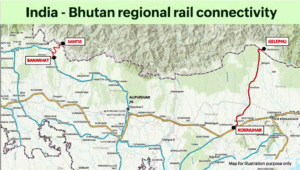
India’s Space Power Revolution
Why This News is Important
- The recent achievements by ISRO (Indian Space Research Organisation), particularly the SpaDeX (Space Docking Experiment) mission, have positioned India among the elite spacefaring nations.
- The success of Chandrayaan-3 and Aditya-1 in 2023 showcased India’s progress in planetary exploration.
- With these milestones, India’s space program is contributing significantly to scientific innovation and addressing critical challenges like climate monitoring, disaster management, and navigation.
Key Terms and Related Facts
- SpaDeX Mission
- Definition: The Space Docking Experiment involves two satellites (‘Chaser’ and ‘Target’) autonomously performing docking maneuvers in orbit.
- Significance:
- Essential for satellite servicing, space station assembly, and interplanetary missions.
- Places India among nations like the US, Russia, and China that have mastered this technology.
- Chandrayaan-3
- Definition: India’s third lunar mission, successfully landing near the Moon’s south pole.
- Fact: This region is rich in water ice, crucial for future lunar exploration.
- Aditya-L1
- Definition: India’s first solar mission, launched to study the Sun’s corona and solar wind.
- Significance: Helps predict space weather, crucial for satellite operations.
- NavIC (Navigation with Indian Constellation)
- Definition: India’s indigenous GPS alternative for accurate navigation.
- Fact: Enhanced in 2024 to provide global coverage and strengthen strategic autonomy.
- SSLV (Small Satellite Launch Vehicle)
- Definition: A cost-effective launch vehicle for deploying small satellites.
- Significance: Targets the booming global nanosatellite market, projected to reach $14 billion by 2031.
Key Highlights of India’s Space-Based Capabilities
- Mastery in In-Orbit Docking and Space Station Development
- SpaDeX Mission:
- Advances India’s technological capabilities in autonomous docking.
- Aids long-term goals like the Gaganyaan program (India’s first manned spaceflight).
- Strengthening Indigenous Satellite Constellations
- Focus on Self-Reliance:
- Building Earth observation satellites for defense, agriculture, and urban planning.
- Upgrading NavIC to rival global systems like GPS.
- Expanding Small Satellite Capabilities
- SSLV and PSLV Programs:
- Serve the commercial satellite market, offering cost-effective launch solutions.
- Enable universities and startups to deploy experimental satellites.
- Boosting Space Startup Ecosystem
- Encouragement through Funding:
- INR 10 billion allocated for space startups in 2024.
- Companies like Pixxel and Skyroot Aerospace are leading innovations in hyperspectral imaging and private rocket launches.
- Advancements in Defense and Dual-Use Technologies
- Strategic Satellites:
- Launch of GSAT-7 enhances communication for defense operations.
- Anti-Satellite (ASAT) capabilities demonstrated in 2019 strengthen national security.
- International Collaborations
- Strategic Partnerships:
- Agreements with NASA and ESA for climate and planetary science missions.
- Collaboration with Axiom Space for leveraging Indian launch capabilities.
- Sustainable Space Practices
- Space Situational Awareness (SSA):
- NETRA program monitors space debris and ensures satellite safety.
- Aligns with global initiatives like the Artemis Accords for responsible exploration.
- Lunar and Interplanetary Missions
- Shukrayaan-1:
- Planned mission to study Venus, reinforcing India’s leadership in planetary science.
- Chandrayaan-3:
- Provides critical insights into lunar resources and geology.
- Socio-Economic Benefits of Space Technology
- Applications in Agriculture and Disaster Management:
- Bhuvan Geoportal assists in real-time disaster monitoring.
- Satellite data supports crop monitoring under the PM-Kisan Scheme.
Challenges in India’s Space Sector
- Limited Budget Allocation
- Fact: India’s space budget is only 0.04% of its GDP, compared to 0.28% for the US.
- ISRO’s budget for 2024-25 is $1.95 billion, much smaller than NASA’s $25 billion.
- Technological Dependence
- Relies on foreign components for advanced systems like propulsion and sensors.
- Indigenous innovation needs faster development, as seen in delays with the CE-20 cryogenic engine.
- Policy and Regulatory Gaps
- Absence of a comprehensive Space Act.
- Unclear mechanisms for liability, intellectual property, and private sector participation.
- Space Debris Concerns
- Increasing satellite launches contribute to orbital debris.
- Fact: By 2022, India had 103 active/defunct satellites and 114 debris objects.
- Brain Drain and Talent Deficit
- Migration of skilled professionals to global space agencies like NASA.
- India’s talent pool in advanced space research is shrinking.
Proposed Measures for Sustained Space Exploration
- Increase Budgetary Allocation
- Introduce sovereign space bonds and public-private co-financing models.
- Establish a dedicated Indian Space Fund for R&D and startups.
- Promote Public-Private Collaboration
- Grant private players access to ISRO facilities.
- Develop joint ventures for satellite constellations and reusable launch vehicles.
- Focus on Indigenous Technology
- Accelerate development of propulsion systems and space-grade semiconductors.
- Establish Space Technology Innovation Hubs.
- Develop Human Capital
- Launch specialized space education programs in universities.
- Establish national space training academies.
- Enhance Space Infrastructure
- Commit to building a modular space station.
- Expand launch capabilities with hypersonic and reusable vehicles.
- Adopt Sustainable Practices
- Invest in debris removal technologies.
- Develop a National Space Sustainability Plan.
Conclusion
India’s space journey reflects its transformation into a global leader in space exploration. Achievements like SpaDeX, Chandrayaan-3, and Aditya-1 highlight ISRO’s capabilities in advanced space technologies and planetary research. While challenges like limited funding and technological dependence persist, measures such as boosting private sector participation, fostering innovation, and enhancing sustainability will ensure India’s sustained growth as a space power. This progress not only strengthens national security and socio-economic development but also aligns India with global efforts to explore the cosmos responsibly.




